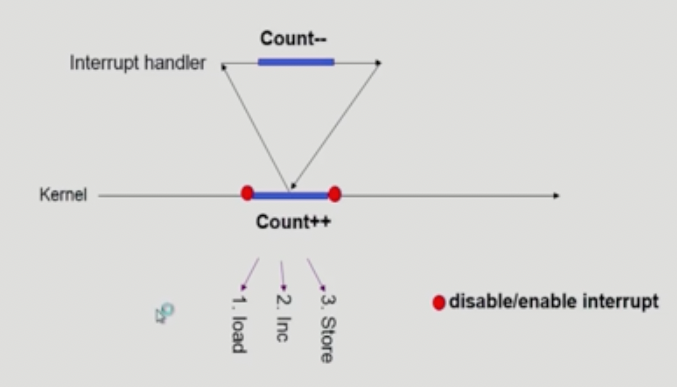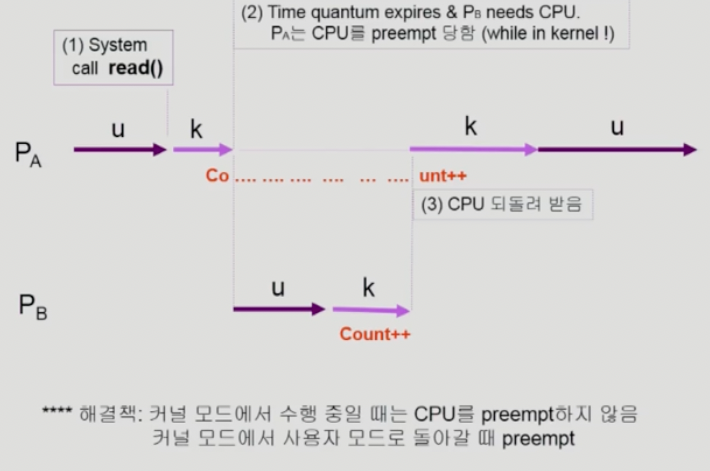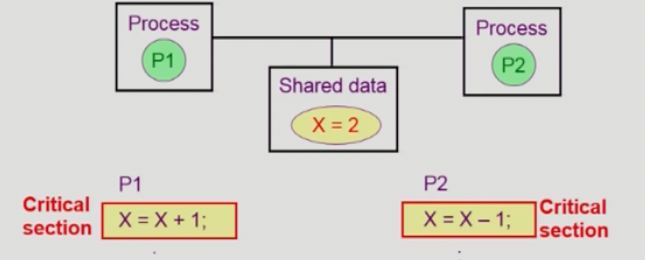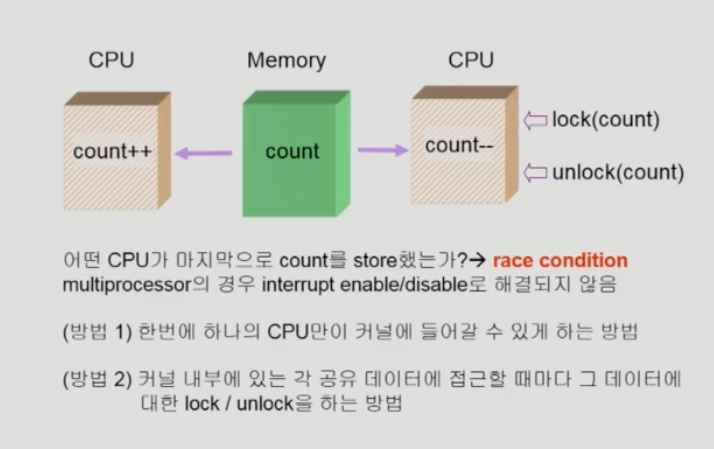OS에서 race condition은 언제 발생하는가?
1. kernel 수행 중 인터럽트 발생 시

2. Process가 system call을 하여 kernel mode로 수행 중인데 context switch가 일어나는 경우

3. Multiprocessor에서 shared memory내의 kernel data

Process Synchronization 문제
- 공유 데이터의 동시 접근은 데이터의 불일치 문제를 발생시킬 수 있다.
- 일관성 유지를 위해서는 협력 프로세스간의 실행 순서를 정해주는 메커니즘 필요
Race condition
- 여러 프로세스들이 동시에 공유 데이터를 접근하는 상황
- 데이터의 최종 연산 결과는 마지막에 그 데이터를 다룬 프로세스에 따라 달라짐
- race condition을 막기 위해서는 concurrent process는 동기화되어야 한다.
The Critical-Section Problem
- n개의 프로세스가 공유 데이터를 동시에 사용하기를 원하는 경우
- 각 프로세스의 code segment에는 공유 데이터를 접근하는 코드인 critical section이 존재
Problem
- 하나의 프로세스가 critical section에 있을 때 다른 모든 프로세스는 critical section에 들어갈 수 없어야 한다.

문제 해결 접근
- 두 개의 프로세스가 있다고 가정 P0, P1
- 프로세스들의 일반적인 구조
do {
entry section
critical section
exit section
remainder section
} while(1);- 프로세스들은 수행의 동기화(synchronize)를 위해 몇몇 변수를 공유할 수 있다. -> synchronization variable
프로그램적 해결법의 충족 조건
Mutual Exclusion (상호 배제)
- 프로세스가 Pi가 critical section 부분을 수행 중이면 다른 모든 프로세스들은 그들의 critical section에 들어가면 안된다.
Progress (진행)
- 아무도 critical section에 있지 않은 상태에서 critical section에 들어가고자 하는 프로세스가 있으면 critical section에 들어가게 해줘야 한다.
Bounded Waiting(유한 대기)
- 프로세스가 critical section에 들어가려고 요청한 후부터 그 요청이 허용될 때까지 다른 프로세스들이 critical section에 들어가는 횟수에 한계가 있어야 한다.
- starvation을 막아야 한다. (특정 프로세스만 접근하지 못하는 상황이 없도록 해야한다.)
가정
모든 프로세스의 수행 속도는 0보다 크다.
프로세스들 간의 상대적인 수행 속도는 가정하지 않는다.
algorithm 1
- synchronization variable
- int turn;
- Process P0
do {
while(turn != 0);
critical section
turn = 1;
remainder section
} while(1);- Satisfies mutual exclusion, but not progress
- 과잉양보 반드시 한번씩 교대로 들어가야만 함 (swap-turn) 다른 process가 turn을 해당 process의 turn으로 critical section으로 접근할 수 있다.
- 특정 프로세스가 더 빈번히 critical section을 들어가야 한다면?
- 다른 프로세스가 해당 프로세스의 turn으로 변경해주기 전까지 기다릴 수 밖에 없음.
algorithm 2
- synchronization variables
- boolean flag[2];
- initially flag[i] = false;
- Pi ready to enter its critical section if(flag[i] == true)
- Process Pi
do {
flag[i] = true;
while(flag[j]);
critical section
flag[i] = false;
remainder section
} while(1);- Satisfies mutual exclusion, but not progress requirement
- 둘 다 2행까지 수행 후 끊임없이 양보하는 상황 발생 가능
algorithm 3 (Peterson 알고리즘)
do {
flag [i] = true;
turn = j;
while (flag[j] && turn == j);
critical section
flag[i] = false;
remainder section
} while(1);- Busy waiting = Spin lock (계속 CPU와 memory를 쓰면서 wait)
Synchronization Hardware
하드웨어적으로 Test & modify를 atomic하게 수행할 수 있도록 지원하는 경우 앞의 문제는 간단히 해결
// 이 메서드가 원자적으로(atimic)하게 수행
boolean test_and_set(boolean *target) {
boolean rv = *target;
*target = true;
return rv;
}
//Synchronization variable
boolean lock = false;
//Process Pi
do{
while(test_and_set(lock));
critical section
lock = false;
remainder section
}int compare-and_swap(int *value, int expected, int new_value) {
int temp = *value;
if(*value == expected)
*value = new_value;
return temp;
}Semaphore
-
앞의 방식들을 추상화시킴
-
Semaphore S
- integer variable
- 아래의 두 가지 atomic 연산에 의해서만 접근 가능
// P는 자원을 획득 P (S) : while(S<=0) do no-op; //waiting S--; // V는 자원을 반납 V (S) : S++;
Critical Section of n Process (Busy-wait)
//Synchronization variable
semaphore mutex; // initially 1 (1개가 CS에 들어갈 수 있다.)
Process Pi
do {
P(mutex);
critical section
V(mutex);
remainder section
} while(1);Busy-wait는 효율적이지 못함
Block& wakeup 방식(=sleep lock)의 구현
- Semaphore 구현
typedef struct
{
int value; // semaphore
struct process *L // process wait queue
} semaphore;
block // 커널은 block을 호출한 프로세스를 suspend 시킴,이 프로세스의 PCB를 semaphore에 대한 wait queue에 넣음
wakeup(P) // block된 프로세스 P를 wakeup시킴, 이 프로세스의 PCB를 ready queue로 옮김P (S) : S.value--;
if(S.value < 0)
{
block(); // add this process to S.L
}
V (S) : S.value++;
if(S.value >= 0)
{
wakeup(P); // remove a process P from S.L
}Busy-wait versus Block/wakeup
- critical section의 길이가 긴 경우 Block/wakeup이 적당하다.
- critial section의 길이가 매우 짧은 경우 Block/Wakeup 오버헤드가 busy-wait 오버헤드보다 더 커질 수 있음
- 일반적으로 Block/wakeup 방식이 더 좋음
자바로 구현해보기
- 원자적 변수로만 모든 상황에서 경쟁 조건을 완벽하게 해결하지 못한다.
- test_and_set과 compare_and_swap에 대해서 자바에서 Atomic변수 또한 compare_and_swap을 통해 구현된 것으로 아는데, 비슷한 기능이 있어서 테스트 겸 코드를 작성해보았다.
import java.util.concurrent.atomic.AtomicBoolean;
public class Peterson {
private static int count = 0;
private static int turn = 0;
private static AtomicBoolean[] flag = new AtomicBoolean[]{new AtomicBoolean(), new AtomicBoolean()};
public static void main(String[] args) throws InterruptedException {
Thread producer = new Thread(new Producer());
Thread consumer = new Thread(new Consumer());
producer.start();
consumer.start();
producer.join();
consumer.join();
System.out.println(count);
}
private static class Producer implements Runnable {
@Override
public void run() {
for (int i = 0; i < 30000; i++) {
flag[0].set(true);
turn = 1;
while (flag[1].get() && turn == 1) {
// waiting
};
count++;
System.out.println(Thread.currentThread().getName()+" producer in critical section 카운트 : "+count);
flag[0].set(false);
}
}
}
private static class Consumer implements Runnable {
@Override
public void run() {
for (int i = 0; i < 30000; i++) {
flag[1].set(true);
turn = 0;
while (flag[0].get() && turn == 0) {
// waiting
};
// critical section
count--;
System.out.println(Thread.currentThread().getName()+" consumer in critical section 카운트 : "+count);
//exit section
flag[1].set(false);
//remainder section
}
}
}
}
import java.util.concurrent.atomic.AtomicBoolean;
public class TestAndSet {
private static AtomicBoolean lock = new AtomicBoolean(false);
private static int count = 0;
public static void main(String[] args) throws InterruptedException {
Thread producer = new Thread(new Producer());
Thread consumer = new Thread(new Consumer());
producer.start();
consumer.start();
producer.join();
consumer.join();
System.out.println(count);
}
public static class Producer implements Runnable {
@Override
public void run() {
for (int i = 0; i < 30000; i++) {
while (lock.getAndSet(true)) {
//do noting..
System.out.println("producer waiting "+ lock);
}
//critical section
count++;
System.out.println("producer in critical section, count = " + count);
lock.set(false);
}
}
}
public static class Consumer implements Runnable {
@Override
public void run() {
for (int i = 0; i < 30000; i++) {
while (lock.getAndSet(true)) {
//do noting..
System.out.println("consumer waiting "+ lock);
}
//critical section
count--;
System.out.println("consumer in critical section, count = " + count);
lock.set(false);
}
}
}
}
import java.util.concurrent.atomic.AtomicBoolean;
import java.util.concurrent.atomic.AtomicInteger;
public class Cas {
private static AtomicBoolean lock = new AtomicBoolean(false);
private static AtomicInteger count = new AtomicInteger(0);
public static void main(String[] args) throws InterruptedException {
Thread producer = new Thread(new Producer());
Thread consumer = new Thread(new Consumer());
producer.start();
consumer.start();
producer.join();
consumer.join();
System.out.println(count);
}
public static class Producer implements Runnable {
@Override
public void run() {
for (int i = 0; i < 100; i++) {
while (lock.compareAndExchange(false, true) ) {
//do noting..
System.out.println("producer waiting "+ lock);
}
//critical section
// try {
// Thread.sleep(10);
// } catch (InterruptedException e) {
// e.printStackTrace();
// }
System.out.println("producer in critical section, count = " + count.incrementAndGet());
lock.set(false);
// try {
// Thread.sleep(10);
// } catch (InterruptedException e) {
// e.printStackTrace();
// }
}
}
}
public static class Consumer implements Runnable {
@Override
public void run() {
for (int i = 0; i < 100; i++) {
while (lock.compareAndExchange(false, true)) {
//do noting..
System.out.println("consumer waiting "+ lock);
}
//critical section
// try {
// Thread.sleep(10);
// } catch (InterruptedException e) {
// e.printStackTrace();
// }
System.out.println("consumer in critical section, count = " + count.decrementAndGet());
lock.set(false);
// try {
// Thread.sleep(10);
// } catch (InterruptedException e) {
// e.printStackTrace();
// }
}
}
}
}